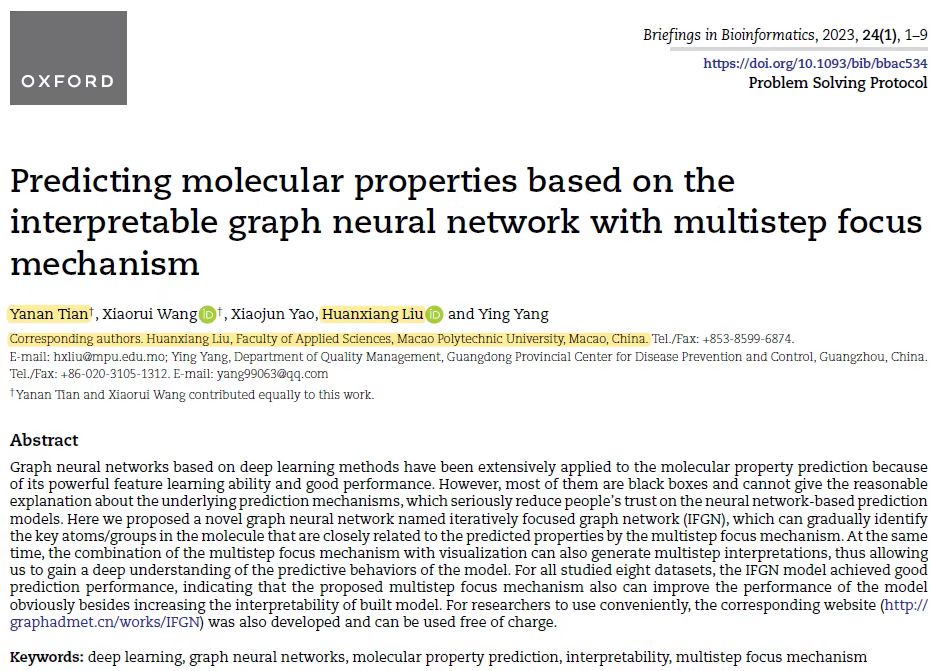Academic work of Macao Polytechnic University was published in top bioinformatics journal
The paper entitled with "Predicting molecular properties based on the interpretable graph neural network with multistep focus mechanism" was published by the top international bioinformatics journal, i.e., Briefings in Bioinformatics 2023, 24(1), 1-9, bbac534 (https://academic.oup.com/bib/article-abstract/24/1/bbac534/6918752?redirectedFrom=fulltext). The work was led by Professor Liu Huanxiang, Academic Leader, Centre for Artificial Intelligence Driven Drug Discovery, Faculty of Applied Sciences, Macao Polytechnic University, with Ms. Tian Yanan, a first-year doctoral student at Macao Polytechnic University, as the first author. The journal is No. 1 in the field of Mathematical and Computational Biology, with an impact factor of 13.994.
The process of drug discovery is essentially the process of gradually optimizing the properties of compounds to obtain safe and effective drugs. Therefore, accurate prediction of various properties of compounds is crucial for the design and optimization of new drugs. In recent years, deep learning technology has been widely used in the fields of molecular property prediction and molecular generation due to its powerful learning ability. However, in the current molecular property prediction methods based on deep learning, most of the models are black boxes, which cannot provide clear guidance for drug design and molecular optimization. To address this issue, this study proposed a novel interpretable graph neural network for molecular property prediction. The model takes the molecular graph as the input representation, uses the message passing neural network as the basic architecture, and improves the prediction performance of the model by embedding a multistep focus mechanism. Among them, the multistep focus mechanism is the core, which mainly includes two stages: the model uses the message passing neural network to update the characteristics of the target node according to the characteristics of the target node and its neighbor nodes, and then uses the focus layer to calculate the focus coefficient of the target node, which represents the importance of the node to the predicted property. In the iterative process, the model continuously adjusts and updates the node weights through a multistep focus mechanism, and finally predicts the molecular properties by identifying the key nodes related to the predicted properties in the molecule. Finally, a large number of experimental results on eight benchmark sets show that the IFGN model has superior prediction performance in both classification tasks and regression tasks, and the visualization results also prove that IFGN can successfully identify key nodes in molecules that are closely related to the predicted properties, thereby increasing the interpretability of the model. In addition, in order to facilitate the use of drug developers, we have also created the related websites.
The Centre for Artificial Intelligence Driven Drug Discovery of Macao Polytechnic University is guided by the strategic needs of the country and Macao in biomedicine, relying on the solid academic advantages of the Faculty of Applied Sciences and the Faculty of Health Sciences and Sports, Macao Polytechnic University. The Centre is committed to the cultivation of interdisciplinary compound person who apply artificial intelligence technology to develop new drugs, with determination in cross-integration of artificial intelligence technology with drug screening, drug design, and drug optimization. In-depth exchanges and cooperation with biomedical companies is also actively promoted for the translational development of our scientific merits.





